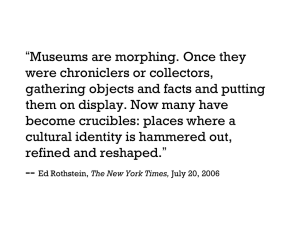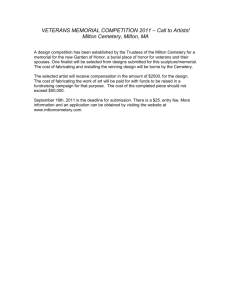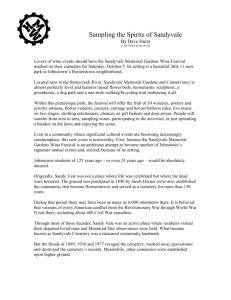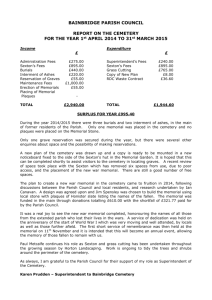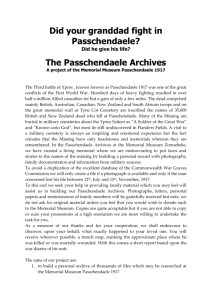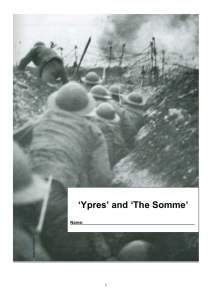Military History Group visit to the Battlefields of Northern France and
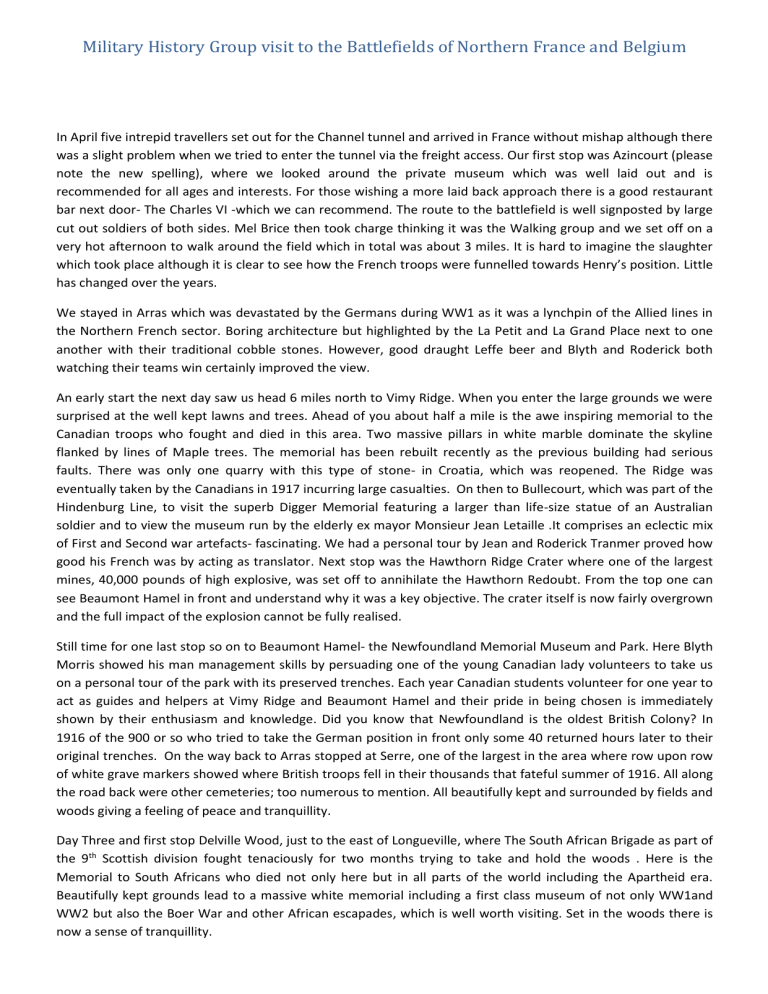
Military History Group visit to the Battlefields of Northern France and Belgium
In April five intrepid travellers set out for the Channel tunnel and arrived in France without mishap although there was a slight problem when we tried to enter the tunnel via the freight access. Our first stop was Azincourt (please note the new spelling), where we looked around the private museum which was well laid out and is recommended for all ages and interests. For those wishing a more laid back approach there is a good restaurant bar next door- The Charles VI -which we can recommend. The route to the battlefield is well signposted by large cut out soldiers of both sides. Mel Brice then took charge thinking it was the Walking group and we set off on a very hot afternoon to walk around the field which in total was about 3 miles. It is hard to imagine the slaughter which took place although it is clear to see how the French troops were funnelled towards Henry’s position. Little has changed over the years.
We stayed in Arras which was devastated by the Germans during WW1 as it was a lynchpin of the Allied lines in the Northern French sector. Boring architecture but highlighted by the La Petit and La Grand Place next to one another with their traditional cobble stones. However, good draught Leffe beer and Blyth and Roderick both watching their teams win certainly improved the view.
An early start the next day saw us head 6 miles north to Vimy Ridge. When you enter the large grounds we were surprised at the well kept lawns and trees. Ahead of you about half a mile is the awe inspiring memorial to the
Canadian troops who fought and died in this area. Two massive pillars in white marble dominate the skyline flanked by lines of Maple trees. The memorial has been rebuilt recently as the previous building had serious faults. There was only one quarry with this type of stone- in Croatia, which was reopened. The Ridge was eventually taken by the Canadians in 1917 incurring large casualties. On then to Bullecourt, which was part of the
Hindenburg Line, to visit the superb Digger Memorial featuring a larger than life-size statue of an Australian soldier and to view the museum run by the elderly ex mayor Monsieur Jean Letaille .It comprises an eclectic mix of First and Second war artefacts- fascinating. We had a personal tour by Jean and Roderick Tranmer proved how good his French was by acting as translator. Next stop was the Hawthorn Ridge Crater where one of the largest mines, 40,000 pounds of high explosive, was set off to annihilate the Hawthorn Redoubt. From the top one can see Beaumont Hamel in front and understand why it was a key objective. The crater itself is now fairly overgrown and the full impact of the explosion cannot be fully realised.
Still time for one last stop so on to Beaumont Hamel- the Newfoundland Memorial Museum and Park. Here Blyth
Morris showed his man management skills by persuading one of the young Canadian lady volunteers to take us on a personal tour of the park with its preserved trenches. Each year Canadian students volunteer for one year to act as guides and helpers at Vimy Ridge and Beaumont Hamel and their pride in being chosen is immediately shown by their enthusiasm and knowledge. Did you know that Newfoundland is the oldest British Colony? In
1916 of the 900 or so who tried to take the German position in front only some 40 returned hours later to their original trenches. On the way back to Arras stopped at Serre, one of the largest in the area where row upon row of white grave markers showed where British troops fell in their thousands that fateful summer of 1916. All along the road back were other cemeteries; too numerous to mention. All beautifully kept and surrounded by fields and woods giving a feeling of peace and tranquillity.
Day Three and first stop Delville Wood, just to the east of Longueville, where The South African Brigade as part of the 9 th Scottish division fought tenaciously for two months trying to take and hold the woods . Here is the
Memorial to South Africans who died not only here but in all parts of the world including the Apartheid era.
Beautifully kept grounds lead to a massive white memorial including a first class museum of not only WW1and
WW2 but also the Boer War and other African escapades, which is well worth visiting. Set in the woods there is now a sense of tranquillity.
Our next stop was the obligatory cup of tea or something stronger for some as our driver, Mike Thompson, found it hard to keep going for too long without a pit stop, in La Boiselle we found an English cafe and after refreshments walked across the road to view the Lochnagar mine-‘La Grand Mine’. The 60,000 pound mine left a crater 90 yards wide and 70feet deep. One can only imagine the devastation wrought when it exploded- it was said it could be heard in London. The mine area is privately owned and now kept as a memorial to all who died here.
We visited the Australian Memorial at Poziere, which is at the highest part of the chalk ridge and was therefore a key objective. In a little over two weeks they suffered nearly 7000 casualties taking the village. The Australian opinion of the British High command was not good after Gallipoli but after taking and holding Poziere where they were subject to massive German shelling and counterattacks it was said that after this the Australians never really trusted the British again. The town was totally destroyed and was rebuilt in the 20/30’s.
On to Thiepval the largest British Memorial to the Missing on the Somme, a colossal ugly building designed by
Edward Lutyens inscribed with the names of 73,367 soldiers whose bodies were never found. There is an informative visitor centre again well worth a visit. Just down the road is the Ulster Memorial, a replica of Helen’s
Tower at Clandeboyne, near Belfast which contrasts with the heavy bland brick Lutyens monument. There is a cafe/museum run by an Irish couple who made us welcome whist we had our usual pit stop for Michael- tea and scones.
We wanted to visit a German cemetery as there are so few in the area and stopped at Fricourt where there is a small one, the graves are marked with black crosses and occasionally a stone has replaced the cross where the soldier had been Jewish, by the family. This was the cemetery where the Red Baron was laid to rest with full honours in 1917 but a few years later was moved back to the family estate in Prussia. Lastly, we had to visit the river Somme as the Battle in the Summer of 1916 was named after this river and drove down to Suzanne a picturesque village where the river widens into a lake.
On our final day we head north to Belgium and our first stop was Messines Ridge- very disappointing as little to see where in 1917 (the Third Battle of Ypres) thousands died to take this high ground before the main assaults could start.
Just outside Ypres is Bedford House Military Cemetery, one of the largest British Cemeteries where there are
10755 graves in four separate areas. Beautifully kept and so quiet even though just off the main road.
It is hard to imagine that Ypres was totally destroyed and rebuilt exactly as it was before, even the medieval square, it is said that Churchill wanted it left as ruin as a memorial to the dead but the Belgians disagreed. We walked around the town walls about 2 miles in circumference surrounded by water where Mel and Blyth thought we needed the exercise. On the memorial (built in Portland stone) at the Menin Gate, which straddles the main road are the names of over 54000 officers and men who fell serving their country, where we all spotted family names – past relatives possibly. We visited the very impressive ‘In Flanders Fields Museum’ which brought home the terrible conditions the battles around Ypres, especially the Third Battle of Ypres in 1917, were fought. As we had to leave to make our way to the tunnel we could not stay to listen to the Last Post which is played every evening at 8pm.
Our last stop was the Toyne Cot Cemetery; this is the largest British Cemetery with over 12000 graves. There is a small museum alongside. It was very busy with coaches regularly pulling in and large numbers of people, especially students walking around, such a different contrast to the quiet tranquil setting at Bedford House
Cemetery.
We then set off for the Tunnel and home. We could only visit a small part of what there is to see in the area so maybe we might plan another trip. We were left with a feeling of the futility of such slaughter that took place on both sides; that so many young men died doing their duty in what both sides saw as a necessary war of attrition.
What a shame that it did not turn out to be the war to end all wars.

